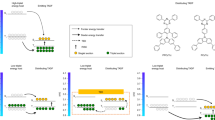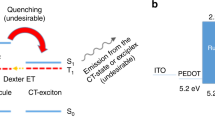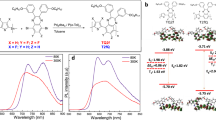Abstract
The origin of efficiency-lifetime trade-off in triplet–triplet fusion (TTF) type blue fluorescent organic light-emitting diodes (OLEDs) was investigated and the device structure to resolve the issue was developed. The efficiency and lifetime were simultaneously improved in the blue OLEDs by developing a multilayer hole transport stack which can adjust carrier densities and recombination zone in the emitting layer (EML). It was found that electron leakage from EML and high spatial density of excitons in the vicinity of the electron blocking layer for high TTF rates by narrow recombination zone are the detrimental factors for efficiency-lifetime trade-off. A multilayer hole transport stack employing a deep highest occupied molecular orbital hole transport layer and an electron blocking layer combined with an appropriate hole blocking layer simultaneously improved the power efficiency by 16% at 500 cd/m2 and lifetime by almost 100% (from 73 h up to 145 h). In addition, the low efficiency in the low luminance region was also completely controlled, resulting in negligible efficiency variation in the entire luminance range.
Graphic Abstract







Similar content being viewed by others
References
Tang, C.W., VanSlyke, S.A.: Organic electroluminescent diodes. Appl. Phys. Lett. 51(12), 913–915 (1987). https://doi.org/10.1063/1.98799
Baldo, M.A., Lamansky, S., Burrows, P.E., Thompson, M.E., Forrest, S.R.: Very high-efficiency green organic light-emitting devices based on electrophosphorescence. Appl. Phys. Lett. 75(1), 4–6 (1999). https://doi.org/10.1063/1.124258
Baldo, M.A., et al.: Highly efficient phosphorescent emission from organic electroluminescent devices. Nature 395, 151 (1998). https://doi.org/10.1038/25954
Kim, S., et al.: Degradation of blue-phosphorescent organic light-emitting devices involves exciton-induced generation of polaron pair within emitting layers. Nat. Commun. 9(1), 1211 (2018). https://doi.org/10.1038/s41467-018-03602-4
Klubek, K.P., Dong, S.-C., Liao, L.-S., Tang, C.W., Rothberg, L.J.: Investigating blue phosphorescent iridium cyclometalated dopant with phenyl-imidazole ligands. Org. Electron. 15(11), 3127–3136 (2014). https://doi.org/10.1016/j.orgel.2014.08.038
Seok, O.C., Min, C.J., Yeob, L.J.: Chemical bond stabilization and exciton management by CN modified host material for improved efficiency and lifetime in blue phosphorescent organic light-emitting diodes. Adv. Opt. Mater. 4(8), 1281–1287 (2016). https://doi.org/10.1002/adom.201600131
Song, W., Kim, T., Lee, Y., Lee, J.Y.: A stepwise energy level doping structure for improving the lifetime of phosphorescent organic light-emitting diodes. J. Mater. Chem. C 5(16), 3948–3954 (2017). https://doi.org/10.1039/c7tc00556c
Tsang, D.P.-K., Matsushima, T., Adachi, C.: Operational stability enhancement in organic light-emitting diodes with ultrathin Liq interlayers. Sci. Rep. 6, 22463 (2016). https://doi.org/10.1038/srep22463
Sajoto, T., Djurovich, P.I., Tamayo, A.B., Oxgaard, J., Goddard, W.A., Thompson, M.E.: Temperature dependence of blue phosphorescent cyclometalated Ir(III) complexes. J. Am. Chem. Soc. 131(28), 9813–9822 (2009). https://doi.org/10.1021/ja903317w
Giebink, N.C., D’Andrade, B.W., Weaver, M.S., Brown, J.J., Forrest, S.R.: Direct evidence for degradation of polaron excited states in organic light emitting diodes. J. Appl. Phys. 105(12), 124514 (2009). https://doi.org/10.1063/1.3151689
Giebink, N.C., et al.: Intrinsic luminance loss in phosphorescent small-molecule organic light emitting devices due to bimolecular annihilation reactions. J. Appl. Phys. 103(4), 044509 (2008). https://doi.org/10.1063/1.2884530
Zhang, Y., Lee, J., Forrest, S.R.: Tenfold increase in the lifetime of blue phosphorescent organic light-emitting diodes. Nat. Commun. 5, 5008 (2014). https://doi.org/10.1038/ncomms6008
Kim, T., Lee, K.H., Lee, J.Y.: Superb lifetime of blue organic light-emitting diodes through engineering interface carrier blocking layers and adjusting electron leakage and an unusual efficiency variation at low electric field. J. Mater. Chem. C 6(31), 8472–8478 (2018). https://doi.org/10.1039/c8tc02286k
Hofmann, S., et al.: Engineering blue fluorescent bulk emitters for OLEDs: triplet harvesting by green phosphors. Chem. Mater. 26(7), 2414–2426 (2014). https://doi.org/10.1021/cm500602y
Zeng, W., et al.: Efficient non-doped fluorescent OLEDs with nearly 6% external quantum efficiency and deep-blue emission approaching the blue standard enabled by quaterphenyl-based emitters. J. Mater. Chem. C 6(16), 4479–4484 (2018). https://doi.org/10.1039/c8tc00317c
Kang, S.K. Taekyung, in preparation
Kuma, H., Hosokawa, C.: Blue fluorescent OLED materials and their application for high-performance devices. Sci. Technol. Adv. Mater. 15(3), 034201 (2014). https://doi.org/10.1088/1468-6996/15/3/034201
Wallikewitz, B.H., Kabra, D., Gélinas, S., Friend, R.H.: Triplet dynamics in fluorescent polymer light-emitting diodes. Phys. Rev. B 85(4), 045209 (2012)
Gentry, S.T., Kopelman, R.: Triplet exciton transport in isotopic mixed naphthalene crystals. I. Kinetic analysis of trapping and fusion. J. Chem. Phys. 81(7), 3014–3021 (1984)
Acknowledgement
This work was supported by National Research Foundation (NRF) Grants funded by the Korean Government (2019R1F1A1061080 and NRF-2019M3D1A2104068).
Author information
Authors and Affiliations
Corresponding author
Additional information
Publisher's Note
Springer Nature remains neutral with regard to jurisdictional claims in published maps and institutional affiliations.
Rights and permissions
About this article
Cite this article
Kang, S., Lee, J.Y. & Kim, T. Unveiling the Root Cause of the Efficiency-Lifetime Trade-Off in Blue Fluorescent Organic Light-Emitting Diodes. Electron. Mater. Lett. 16, 1–8 (2020). https://doi.org/10.1007/s13391-019-00180-5
Received:
Accepted:
Published:
Issue Date:
DOI: https://doi.org/10.1007/s13391-019-00180-5




